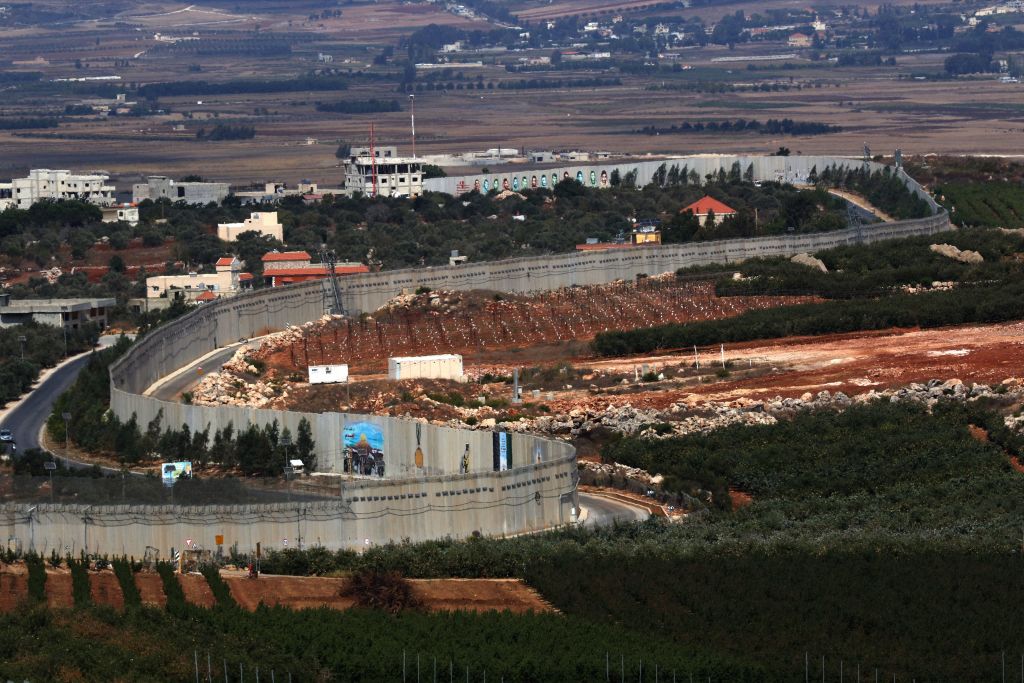Listen to article
Little noticed in press coverage of the American-mediated Israel-Lebanon maritime agreement is the possibility of the accord facilitating another breakthrough in the Arab-Israel conflict. Lebanon and Israel have not just agreed on a provisional maritime separation line but also have established a “permanent maritime boundary,” according to President Joe Biden. For the first time in history, Lebanon has acknowledged that it has a boundary with Israel. And if a blue-water boundary has now been established, why should it not be extended to dry land? Indeed, why not contemplate continued U.S. mediation to solve land-based disputes between the parties or even consider steps toward establishing peace between two states still officially at war?
When it was first announced that Lebanon and Israel had agreed to American-drafted terms for a maritime understanding, I was asked by an interviewer whether I thought this was a first step toward Lebanon-Israel normalization. My reply was categorical: “No.” Now, having read the terms, I see potential opportunity. Whether it will be seized is doubtful; powerful forces define their own interests in terms of blocking Israel-Lebanon conflict mitigation on land and preventing eventual peace. Yet to avoid making the effort would seem, given the boundary facet of the maritime agreement, to be unthinkable.
Since the establishment of Israel in May 1948, Lebanon has consistently denied it has a boundary of any kind with the Jewish State. It had, for a quarter-century, a “1923 international boundary” with British Mandate Palestine; indeed, it has maintained that this boundary – with Palestine – still exists. In 1949, Lebanon signed an armistice agreement establishing a line separating armed forces, one supposed to correspond to the 1923 mandate boundary. And in 2000, it agreed (with reservations) to a United Nations-drawn “Blue Line” designed to confirm Israel’s complete withdrawal from Lebanese territory. Until now, Lebanon has refrained from asserting it has a boundary of any kind with Israel.
The text of the U.S.-brokered accord says that the point of the mediation was “to delineate the maritime boundary between the Republic of Lebanon and the State of Israel.” This was no mere maritime separation line (the term of art used during the 2011-2012 maritime mediation); an international boundary was being explicitly created, with the consent of both parties. During the talks a decade ago (over which I presided as mediator) both sides agreed that the subject under discussion was a provisional line that could change if the parties were ever to consider creating a boundary. The objective then, in effect, was to extend the Blue Line out to sea because Lebanon was not prepared to go all the way to boundary delineation. Biden’s use of the words “permanent maritime boundary” accurately depicts what Lebanon is now prepared to recognize.
Still, the maritime understanding and mutual boundary recognition seem not to terminate the legal state of war between Lebanon and Israel. Indeed, at least one noted expert – Asher Kaufman of Notre Dame – argued in an interview with The Times of Israel, “There is a very clear process for making a maritime boundary internationally recognized, and this agreement did not follow this process.” Whatever that “process” might be, however, surely it is still worth noting that Lebanon and Israel will recognize, by accepting the terms of the maritime arrangement, that they do indeed have a boundary. Who exactly would deny international recognition for such an undertaking?
Although experts will argue the fine points of what has been agreed – debating how the word “boundary” applies to territorial limits (12 nautical miles in the cases of Lebanon and Israel), contiguous zones (another 12 nautical miles), and exclusive economic zones (in this case extending out to a line drawn by Cyprus) – the potential opportunity lying ahead is in the hands of political leaders and diplomats, not scholars and lawyers.
When I headed the U.S. maritime mediation between Israel and Lebanon, I hoped agreement on a maritime separation line would lead to American mediation of Blue Line land disputes between the two countries. The aim would not have been peace in the formal sense, which at the time was completely dependent on Syria and Israel first coming to terms. Rather, the purpose of extending mediation from sea to land would have been to eliminate, to the extent possible, disputes over the trace of the Blue Line – disputes that caused periodic deadly armed clashes. Now that a maritime agreement has been reached, will the anticipated land mediation opportunity of 2012 materialize?
The view here is that two related but distinct opportunities exist. If all parties were to focus exclusively on conflict mitigation and prevention, U.S. mediation might transition directly from sea to land. If the objective was to seek formal peace between the parties, something more creative and complicated would be required.
Land boundary issues to be addressed and settled would have two components: the trace of the Blue Line where it more or less corresponds to the 1949 Lebanon-Israel armistice line and the extended Blue Line, which separates Lebanon from the Golan Heights.
If conflict mitigation and prevention were the aim, identifying mutually agreeable adjustments to bring the Blue Line into closer alignment with the 1949 armistice line would not require major innovations in the craft of diplomacy. There are points of great sensitivity, particularly with respect to at least one Israeli populated area, but feasible tradeoffs appear to be readily available.
It is where the Blue Line climbs up toward the Golan Heights that real challenges emerge. The town of Ghajar, occupied by Israel since 1967, is now (on paper) divided by the Blue Line. When I studied the Ghajar problem a decade ago, it seemed that the residents of the town preferred existing Israeli rule to either Lebanese or Syrian.
But it is the so-called “Shebaa Farms and Kfar Shouba Hills” controversy that presents the real boundary-related and peace obstacle. Israel’s unilateral withdrawal from Lebanon in May 2000 threatened to put Hezbollah out of the “Lebanese Resistance” business altogether. With no occupation, what to resist?
The occupation-resistance dilemma was solved by a senior Lebanese intelligence officer who recalled there was a slim piece of the Golan Heights adjoining Lebanon that past Lebanese governments had claimed and had asked Syria to transfer. It seemed that Lebanese nationals owned property in this narrow strip and that lax French efforts during the mandate era to delineate a boundary between Syria and Lebanon had, in this area (and others), produced considerable ambiguity. Syria-Lebanon talks took place (before the June 1967 War), but the land remained under Syrian jurisdiction until it was occupied by Israeli forces in June 1967. Until 2000, there were no Lebanese claims pertaining to the area in question. Lebanese banknotes and maps situated the area inside Syria.
By the summer of 2000, however, Hezbollah was claiming that Israel’s occupation had not ended after all; that it was still sitting atop Lebanese territory in the form of the Shebaa Farms and Kfar Shouba Hills. The Government of Lebanon was then obliged to fall in behind Hezbollah. Finally, the Syrian foreign minister telephoned U.N. Secretary-General Kofi Annan to affirm that the land in question was indeed Lebanese.
This assertion that Israel still occupies Lebanese land is the basis of Hezbollah’s claim to be “the Lebanese Resistance.” It is Hezbollah’s main rationale for maintaining a potent armed force independent of the Government of Lebanon and the Lebanese Armed Forces. Yes, Hezbollah has approved an arrangement for Lebanon to create a maritime boundary with Israel. But no, the organization, responsive as it is to Iranian objectives and priorities, has manifested no interest at all in settling Blue Line disputes, much less advancing Lebanon-Israel peace.
Impacting, as it does, the status of Hezbollah as “the Lebanese Resistance” and Iran’s role in Lebanon, American mediation of the Shebaa Farms-Kfar Shouba Hills matter would seem to be a diplomatic bridge too far. Indeed, U.S. mediation of Blue Line disputes restricted to the vicinity of the 1949 armistice line might well encounter a Hezbollah veto.
But what if Israel were to signal Lebanon that peace, meeting the needs of both sides, would include the Shebaa Farms and Kfar Shouba Hills being transferred to Lebanon? Lebanon and Israel would both be free to cite Syria’s 2000 recognition of Lebanon’s claim. Indeed, Syria’s recognition implicitly demanded that Israel hand over to Lebanon the acreage in question without reference to Damascus. It would seem, therefore, that debates over the status of the Golan Heights (occupied Syrian territory v. Israeli sovereignty) would not preclude the transfer to Lebanon of the strip in question, as Syria is on record designating it as Lebanese territory.
How might Hezbollah react to such an Israeli offer? One would not likely lose money betting on it to reject the initiative and uphold its eternal right to bear arms, citing perhaps its intention to liberate Jerusalem. It might resurrect the failed predecessor to the Shebaa Farms-Kfar Shouba gambit, the so-called “Seven Villages” claim. But Hezbollah’s refusal to accept victory and contemplate standing down as a military force would be an edifying spectacle indeed for the Lebanese people – including Hezbollah’s constituents – to witness.
Israel-Lebanon peace would, to be sure, require much more than the transfer of territory Israel regards as its own: elevated land deemed to be of great security significance by the Israel Defense Forces. There is the issue of a just resolution of the status of Palestinian refugees in Lebanon. Age-old water-related controversies involving the Hasbani River would have to be resolved. Israeli assistance in removing land mines and cluster munitions from Lebanese territory must be secured. Agreements on diplomatic representation, trade, tourism, and the like would be mandatory. A land boundary from the Mediterranean Sea up toward Mount Hermon would have to be delineated and demarcated. And verifiable security arrangements, including the disarmament of Hezbollah and agreed rules for keeping the peace along the border, must be arrived at.
Perhaps Israel, regardless of who wins the forthcoming parliamentary elections, will prove to be as interested in making peace with Lebanon as Hezbollah is in Lebanon making peace with Israel. Perhaps the maritime agreement is all these parties will be able to handle for the foreseeable future. Clearly the Government of Lebanon, even though it is taking the significant step of recognizing it has a maritime boundary with the Jewish State, is in no position to initiate next steps, whether they involve resolving Blue Line issues or exploring the possibility of peace with Israel. Iranian suzerainty over significant parts of the Cedar Republic will likely obstruct for some time to come not only peace with the southern neighbor but also economic recovery and the creation of a viable Lebanese state.
Still, the maritime agreement suggests that one of the long-accepted truisms of Arab-Israel peace efforts – Lebanon will be the last to make peace with Israel – may no longer be operative. It is at least a proposition worth testing. Israel can, if it wishes, test it. Arab states at peace with Israel can support a cautious but forthcoming official Lebanese response. Less ambitiously, Washington can offer its mediation services to help settle aggravating and dangerous Blue Line disputes.
Implementing the maritime agreement and sustaining it with good faith is job one. But that which has been agreed at sea should be applicable on land as well. It is an opportunity worth exploring and seizing.
Ambassador Frederic C. Hof is Bard College’s Diplomat-in-Residence, and is the author of Reaching for the Heights: The Inside Story of a Secret Attempt to Reach a Syrian-Israeli Peace. He served as ambassador and special advisor for transition in Syria under President Barack Obama, with a distinguished career at the United States Army and the Department of State.
The views expressed in this article are those of the author and not an official policy or position of the New Lines Institute.







